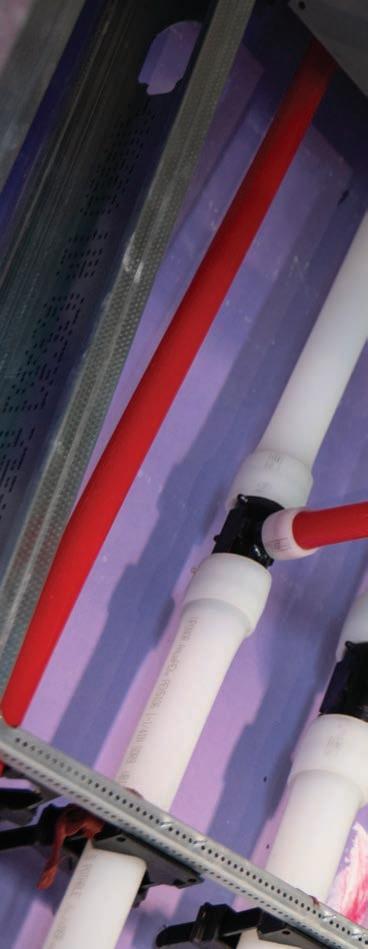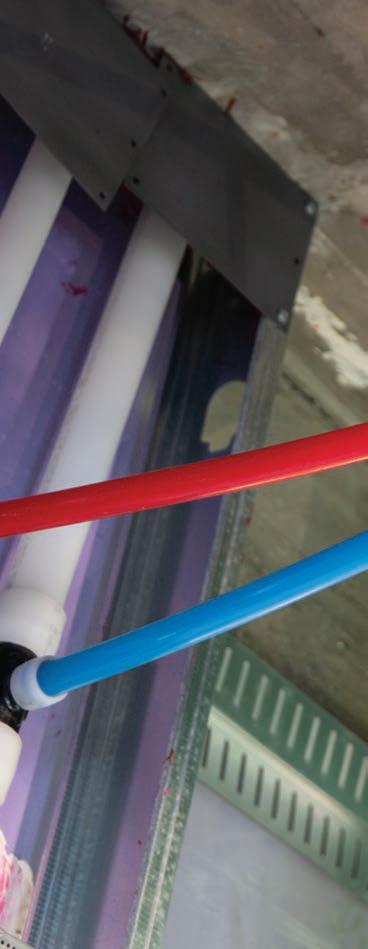
3 minute read
The Benefits of PEX
Almost every aging facility requires repiping.
By Kevin Wong
Nearly half a million commercial and industrial structures are in service across Canada. Many are past the 50-year mark. The cost to renovate aging buildings now equals that of new construction— and continues to increase every year.
From floor to ceiling and mechanical room to rooftop, these buildings demand material and equipment upgrades that meet today’s standards for health, safety, comfort and sustainability. Keeping projects on schedule and budget can also be a challenge, given significant labour constraints.
While some of a building’s existing materials and equipment may be kept in place during essential renovations, nearly every aging facility requires repiping for its domestic water and/or hydronic distribution systems. One preferred solution, which began to be adopted in the early 1980s as an alternative to copper and other metals for radiant floor heating, is cross-linked polyethylene (PEX).
PEX is lighter and more flexible than metal, enabling faster and easier piping connections, without the need for an open flame on a job site. It increases safety, halves installation time and ensures minimal invasiveness when repiping histor- ical buildings.

Early adopters mainly valued the speed, reliability and cost of PEX when they used it to replace copper and other metals. Today’s building owners have discovered the material also offers sustainability benefits, including corrosion resistance and resilience in freezing conditions.
Indeed, with a life expectancy of up to 100 years in a properly designed system, PEX can outlast many buildings! And with cold expansion connections that cannot be dr y-fit, it eliminates the added concern of blowoffs with an unmade fitting.
As for cost, PEX is not a traded commodity, so it does not experience price fluctuations like metals d o. Its stable material cost is typically lower than copper’s, making it easier to budget for long-term projects. And its ease of installation saves on labour costs.
30%
Types
As more engineers begin to specify PEX, it is important to understand the material’s various characteristics and design considerations.
There are three different types of PEX, which vary by manufacturing method: PEX-a, PEX-b and PEX-c. Manufacturing varies by degree and uniformity of crosslinking; the higher the degree and uniformity, the more durable, flexible and freeze-resilient the pipe.
PEX-a offers the highest degree of crosslinking at around 85%. PEX-b offers 65 to 70%, while PEX-c pipe provides 70 to 75%.
Temperature and pressure
Hydrostatic temperature and pressure ratings for PEX are 93 C (200 F) at 5.5 bar (80 psi), 82 C (180 F) at 6.9 bar (100 psi) and 23 C (73 F) at 11 bar (160 psi). Operating temperature and pressure ratings in domestic hot water and recirculation should not exceed 60 C (140 F) at 5.5 bar (80 psi).
PEX’s low weight and flexibility help reduce installation time and ensure minimal invasiveness when repiping historical buildings.
Sizing
PEX’s outside diameter (OD) is equal to copper tube size (CTS) and its wall thickness is one-ninth the OD, for a Standard Dimension Ratio (SDR) 9 classification. This allows the material to use the same hangers and supports as copper, in addition to any CTS insulations.
The inside diameter (ID) of PEX is slightly smaller than copper pipe, but since PEX is three times smoother than new copper pipe, it can be designed for higher velocities, reducing the difference in flow characteristics.

The smaller ID also offers system volume water savings, whereby smaller pumps, heat sources and tanks can deliver the same level of comfort and hot water to the user.
Thermal conductivity, expansion and contraction
PEX has a very low co-efficient of thermal conductivity of 0.38 W/ (mK), so it does not ‘sweat’ like copper pipe. Its thicker walls offer insulation values of approximately R-0.19.
Additionally, the heat transfer from copper is much greater. PEX offers up to 30% better insulating value, when comparing uninsulated PEX to uninsulated copper pipe.
should not exceed 7.5 m. Maximum horizontal spacing for bare PEX is 0.8 m, but using pipe support steel channels increases the support spacing to 2.4 m.
Direct burial
Further, PEX pipe expands and contracts at a rate of 27.94 mm per 30.48 m of pipe with every 5.56 C temperature change. Using a support steel channel in suspended-piping applications in conjunction with fixed anchor points can reduce this expansion and contraction rate to an acceptable level.
Support spacing
Maximum vertical spacing requires support at the base and at the floor of alternate storeys. The spacing
PEX pipe and certain certified/listed fittings are approved for direct burial in soil or concrete. There is also pre-sleeved PEX with a highdensity polyethylene (HDPE) corrugated sleeve that provides added protection for installations in concrete slabs or rocky soil. The sleeve allows for quick and easy removal and replacement of the PEX pipe, if necessary, without having to break up the slab or soil.
Specifying the system
Finally, it is worth noting that in some cases, CSA Group and other third-party certification agencies have validated the performance of complete PEX systems, including the pipe, ring and fitting. Thus, specifying a complete system can help prevent poor performance.










